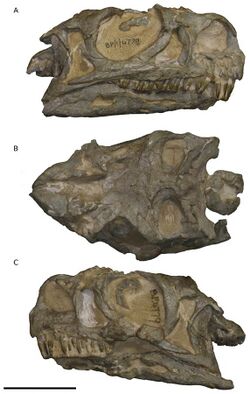Biology:Ngwevu
| Ngwevu | |
|---|---|

| |
| Holotype skull | |
| Scientific classification | |
| Domain: | Eukaryota |
| Kingdom: | Animalia |
| Phylum: | Chordata |
| Clade: | Dinosauria |
| Clade: | Saurischia |
| Clade: | †Sauropodomorpha |
| Family: | †Massospondylidae |
| Genus: | †Ngwevu Chapelle et al., 2019[1] |
| Species: | †N. intloko
|
| Binomial name | |
| †Ngwevu intloko Chapelle et al., 2019[1]
| |
Ngwevu is a genus of massospondylid sauropodomorph dinosaur from the Lower Jurassic of South Africa . The genus contains one species, Ngwevu intloko.
Discovery and naming
The genus Ngwevu is known from only one specimen, BP/1/4779, which is stored in the Environmental Studies Institute of the University of the Witwatersrand, in Johannesburg, South Africa. The holotype specimen was discovered in 1978 by James William Kitching in the Tevrede Farm, located in Fouriesburg district, South Africa. The strata which preserved the specimen was located in the Clarens Formation,[2] which is Pliensbachian-early Toarcian in age.[3] The specimen was initially considered a specimen of the genus Massospondylus[4][5] but in 2019 was designated as a new genus and species Ngwevu ntloko (pronounced "'Ng-g'where-voo" IPA: [ŋ.gəˈweːvuː]; directly from Xhosa 'ngwevu' and 'intloko' meaning "grey skull").[1]
Description
Ngwevu can be distinguished from other sauropodomorphs based on a unique combination of 16 traits, including one unique feature: a ridge on the lateral surface of the backside of the jugal. Previously, the specimen was noted to share some different traits compared to other Massospondylus specimens but the differences were considered a result of deformation.[4] In the description of the new genus, it was revealed that these differences cannot be attributed to deformation, and in fact the specimen is well intact. Another hypothesis presumed the differences found in Ngwevu could be attributed to a less advanced ontogenetic stage, with some paleontologists considering it to be a younger specimen of Massospondylus.[5] However, histological study of the holotype of Ngwevu suggests it was an adult (about 10 years old) when it fossilized, rejecting this hypothesis as well. The describing authors of Ngwevu also noted that Ngwevu was proportionately more robust than specimens of Massospondylus.[1]
Phylogeny
Despite the fact that Ngwevu could be distinguished from Massospondylus, there are several shared features between the two genera. A phylogenetic analysis conducted in the describing paper corroborates this, placing Ngwevu intloko in the Massospondylidae. A portion of the analysis is reproduced below.[1]
| Massopoda |
| |||||||||||||||||||||||||||||||||||||||||||||||||||||||||||||||||||||
Paleobiology
The snout of Ngwevu has been noted to have a wider snout than Massospondylus, which has been proposed to be a sign of a more generalist diet as opposed to selective behavior. The distinctive characteristics of Ngwevu may have allowed a more powerful bite compared to Massospondylus which suggests niche partititioning between the two taxa.[1]
References
- ↑ 1.0 1.1 1.2 1.3 1.4 1.5 Chapelle, Kimberley E. J.; Barrett, Paul M.; Botha, Jennifer; Choiniere, Jonah N. (August 5, 2019). "Ngwevu intloko: a new early sauropodomorph dinosaur from the Lower Jurassic Elliot Formation of South Africa and comments on cranial ontogeny in Massospondylus carinatus". PeerJ 7: e7240. doi:10.7717/peerj.7240. PMID 31403001.
- ↑ Viglietti, P.A.; McPhee, B.W.; Bordy, E.M.; Sciscio, L.; Barrett, P.M.; Benson, R.B.J.; Wills, S.; Chapelle, K.E.J. et al. (2020-06-01). "Biostratigraphy of the Massospondylus Assemblage Zone (Stormberg Group, Karoo Supergroup), South Africa". South African Journal of Geology 123 (2): 249–262. doi:10.25131/sajg.123.0018. ISSN 1996-8590. https://content.ebscohost.com/ContentServer.asp?T=P&P=AN&K=144986947&S=R&D=aph&EbscoContent=dGJyMNXb4kSeprQ4v%2BbwOLCmsEqeqLFSsae4S6%2BWxWXS&ContentCustomer=dGJyMPGvtU%2BxqrFOuePfgeyx44Dt6fIA.
- ↑ Bordy, Emese M.; Abrahams, Miengah; Sharman, Glenn R.; Viglietti, Pia A.; Benson, Roger B.J.; McPhee, Blair W.; Barrett, Paul M.; Sciscio, Lara et al. (April 2020). "A chronostratigraphic framework for the upper Stormberg Group: Implications for the Triassic-Jurassic boundary in southern Africa". Earth-Science Reviews 203: 103120. doi:10.1016/j.earscirev.2020.103120. ISSN 0012-8252. https://par.nsf.gov/servlets/purl/10144138.
- ↑ 4.0 4.1 Gow, Chris E. (1990). "Morphology and growth of the Massospondylus braincase (Dinosauria Prosauropoda)". Palaeontologia Africana 27: 59–75. https://core.ac.uk/download/pdf/39674753.pdf.
- ↑ 5.0 5.1 Sues, Hans-Dieter; Reisz, Robert R.; Hinic, Sanja; Raath, Michael A. (30 December 2004). "On the skull of Massospondylus carinatus Owen, 1854 (Dinosauria: Sauropodomorpha) from the Elliot and Clarens formations (Lower Jurassic) of South Africa". Annals of Carnegie Museum 73 (4): 239–257. doi:10.5962/p.316084. https://www.researchgate.net/publication/289768465.
Wikidata ☰ Q66141920 entry
 |

